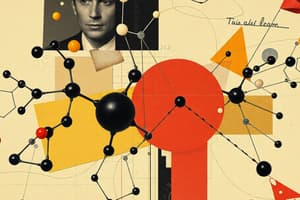Podcast
Questions and Answers
What type of bond is formed when two monosaccharides are linked together to form a disaccharide?
What type of bond is formed when two monosaccharides are linked together to form a disaccharide?
- Hydrogen bond
- Glycosidic bond (correct)
- Peptide bond
- Ionic bond
Which of the following is NOT a characteristic of carbohydrates?
Which of the following is NOT a characteristic of carbohydrates?
- They can form long polymers called polysaccharides.
- They are primarily composed of nonpolar molecules with hydrophobic properties. (correct)
- They are the primary source of energy for most organisms.
- They are composed of carbon, hydrogen, and oxygen atoms.
What type of reaction is used to break down polymers into monomers?
What type of reaction is used to break down polymers into monomers?
- Condensation reaction
- Redox reaction
- Dehydration reaction
- Hydrolysis reaction (correct)
Which of the following is a disaccharide?
Which of the following is a disaccharide?
What is the general formula for carbohydrates?
What is the general formula for carbohydrates?
Flashcards
Organic Molecules
Organic Molecules
Molecules that contain carbon, abundant in living organisms.
Carbon Atom
Carbon Atom
An atom with 4 electrons in its outer shell, forming up to four bonds.
Dehydration Reaction
Dehydration Reaction
Process that links monomers to form polymers by removing water.
Monosaccharides
Monosaccharides
Signup and view all the flashcards
Polysaccharides
Polysaccharides
Signup and view all the flashcards
Study Notes
Organic Molecules
- Organic molecules contain carbon.
- Organic molecules are abundant in living organisms.
- Macromolecules are large, complex organic molecules.
Carbon Atom
- Carbon has four electrons in its outer shell.
- Carbon needs four more electrons to fill its outer shell.
- Carbon can make up to four bonds, usually single or double bonds.
- Carbon can form nonpolar or polar bonds, with polar bonds making molecules water-soluble.
Dehydration and Hydrolysis Reactions
- Dehydration reactions link monomers to form polymers.
- Hydrolysis breaks polymers down into monomers.
Carbohydrates
- Carbohydrates consist of carbon, hydrogen, and oxygen atoms.
- Formula: Cn(H2O)n.
- Most carbon atoms in a carbohydrate are linked to a hydrogen atom and a hydroxyl group.
- Carbohydrates are polymers composed of monomer units called monosaccharides.
Monosaccharides
- Monosaccharides are the monomer units of carbohydrates.
- They are the simplest sugars.
- Most common monosaccharides have 5 or 6 carbons.
Disaccharides
- Disaccharides are composed of two monosaccharides.
- They are joined by a dehydration or condensation reaction, forming a glycosidic bond.
- Disaccharides are broken apart by hydrolysis.
- Examples include sucrose, maltose, and lactose.
Polysaccharides
- Polysaccharides are long polymers formed by linking many monosaccharides.
Studying That Suits You
Use AI to generate personalized quizzes and flashcards to suit your learning preferences.




